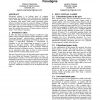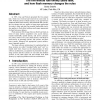2614 search results - page 208 / 523 » Information System Architectures: From Art to Science |
HICSS
2003
IEEE
14 years 1 months ago
2003
IEEE
Over the years, our group, led by Bob Balzer, designed and implemented three domain-specific languages for use by outside people in real situations. The first language described t...
SMC
2007
IEEE
14 years 2 months ago
2007
IEEE
— The computational understanding of continuous human movement plays a significant role in diverse emergent applications in areas ranging from human computer interaction to phys...
ACMSE
2009
ACM
14 years 2 months ago
2009
ACM
Educational gaming is an exciting genre of computer programming that attempts to find interesting and compelling ways to teach while also being fun. Research has been conducted to...
ATAL
2004
Springer
14 years 1 months ago
2004
Springer
As the science of multi-agent systems matures, many developers are looking to deploy mission critical applications on distributed multi-agent systems (DMAS). Due to their distribu...
DAMON
2007
Springer
14 years 2 months ago
2007
Springer
In 1987, Gray and Putzolo presented the five-minute rule, which was reviewed and renewed ten years later in 1997. With the advent of flash memory in the gap between traditional RA...


